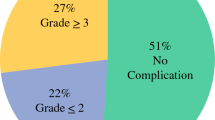Abstract
Purpose
Cytoreductive surgery combined with hyperthermic intraperitoneal chemotherapy (HIPEC) is now a recognized treatment for peritoneal carcinomatosis (PC). The objective of this phase I study is to determine the maximum tolerated dose of irinotecan (CPT-11) when used with mitomycin C (MMC) for closed abdomen HIPEC.
Methods
Patients with PC fulfilling the inclusion criteria were studied. All underwent cytoreductive surgery and closed abdomen HIPEC with 0.7 mg/kg MMC and an escalating dose of irinotecan. Grade 4 (National Cancer Institute grading system) surgical and hematological complications were used to identify dose-limiting toxicity (DLT).
Results
12 patients were studied. At the first dose level of irinotecan (100 mg/m2), one patient developed a grade 4 hematological toxicity. Three other patients were included at the same level with no toxicity. Three patients were then included at the second dose level (150 mg/m2 irinotecan), of whom one developed a grade 4 surgical complication. Three further patients were thus included at the second dose level. Of these three, two patients developed DLT [grade 4 neutropenia in one, grade 4 neutropenia and thrombocytopenia with an intra-abdominal lymphatic fistula requiring reoperation (grade 4 surgical complication) in the other]. Dose escalation was stopped at this level. The maximum tolerated dose of irinotecan was determined to be 100 mg/m2.
Conclusion
Closed HIPEC combining MMC and irinotecan is safe and feasible. For HIPEC, the maximum tolerated dose of irinotecan is 100 mg/m2 when used with 0.7 mg/kg MMC.

Similar content being viewed by others
References
Sugarbaker PH. Peritonectomy procedures. Ann Surg. 1995;221:29–42.
Glehen O, Cotte E, Kusamura S, Deraco M, Baratti D, Passot G, et al. Hyperthermic intraperitoneal chemotherapy: nomenclature and modalities of perfusion. J Surg Oncol. 2008;98:242–6.
Sugarbaker PH. New standard of care for appendiceal epithelial neoplasms and pseudomyxoma peritonei syndrome? Lancet Oncol. 2006;7:69–76.
Elias D, Gilly F, Boutitie F, Quenet F, Bereder JM, Mansvelt B, et al. Peritoneal colorectal carcinomatosis treated with surgery and perioperative intraperitoneal chemotherapy: retrospective analysis of 523 patients from a multicentric French study. J Clin Oncol. 2010;28:63–8.
Verwaal VJ, Bruin S, Boot H, van Slooten G, van Tinteren H. 8-year follow-up of randomized trial: cytoreduction and hyperthermic intraperitoneal chemotherapy versus systemic chemotherapy in patients with peritoneal carcinomatosis of colorectal cancer. Ann Surg Oncol. 2008;15:2426–32.
Yan TD, Morris DL. Cytoreductive surgery and perioperative intraperitoneal chemotherapy for isolated colorectal peritoneal carcinomatosis: experimental therapy or standard of care? Ann Surg. 2008;248:829–35.
Yan TD, Welch L, Black D, Sugarbaker PH. A systematic review on the efficacy of cytoreductive surgery combined with perioperative intraperitoneal chemotherapy for diffuse malignancy peritoneal mesothelioma. Ann Oncol. 2007;18:827–34.
Glehen O, Schreiber V, Cotte E, Sayag-Beaujard AC, Osinsky D, Freyer G, et al. Cytoreductive surgery and intraperitoneal chemohyperthermia for peritoneal carcinomatosis arising from gastric cancer. Arch Surg. 2004;139:20–6.
Glehen O, Gilly FN, Arvieux C, Cotte E, Boutitie F, Mansvelt B, et al. Peritoneal carcinomatosis from gastric cancer: a multi-institutional study of 159 patients treated by cytoreductive surgery combined with perioperative intraperitoneal chemotherapy. Ann Surg Oncol. 2010;17:2370–7.
Scaringi S, Kianmanesh R, Sabate JM, Facchiano E, Jouet P, Coffin B, et al. Advanced gastric cancer with or without peritoneal carcinomatosis treated with hyperthermic intraperitoneal chemotherapy: a single western center experience. Eur J Surg Oncol. 2008;34:1246–52.
Le Page S, Kwiatkowski F, Paulin C, Mohamed F, Pezet D, Chipponi J, et al. In vitro thermochemotherapy of colon cancer cell lines with irinotecan alone and combined with mitomycin C. Hepatogastroenterology. 2006;53:693–7.
Elias D, Matsuhisa T, Sideris L, Liberale G, Drouard-Troalen L, Raynard B, et al. Heated intra-operative intraperitoneal oxaliplatin plus irinotecan after complete resection of peritoneal carcinomatosis: pharmacokinetics, tissue distribution and tolerance. Ann Oncol. 2004;15:1558–65.
Elias D, Raynard B, Bonnay M, Pocard M. Heated intra-operative intraperitoneal oxaliplatin alone and in combination with intraperitoneal irinotecan: pharmacologic studies. Eur J Surg Oncol. 2006;32:607–13.
Ortega-Deballon P, Facy O, Jambet S, Magnin G, Cotte E, Beltramo JL, et al. Which method to deliver hyperthermic intraperitoneal chemotherapy with oxaliplatin? An experimental comparison of open and closed techniques. Ann Surg Oncol. 2010;17:1957–63.
Cotte E, Passot G, Mohamed F, Vaudoyer D, Gilly FN, Glehen O. Management of peritoneal carcinomatosis from colorectal cancer: current state of practice. Cancer J. 2009;15:243–8.
Glehen O, Mithieux F, Osinsky D, Beaujard AC, Freyer G, Guertsch P, et al. Surgery combined with peritonectomy procedures and intraperitoneal chemohyperthermia in abdominal cancers with peritoneal carcinomatosis: a phase II study. J Clin Oncol. 2003;21:799–806.
Glehen O, Osinsky D, Cotte E, Kwiatkowski F, Freyer G, Isaac S, et al. Intraperitoneal chemohyperthermia using a closed abdominal procedure and cytoreductive surgery for the treatment of peritoneal carcinomatosis: morbidity and mortality analysis of 216 consecutive procedures. Ann Surg Oncol. 2003;10:863–9.
Elias D, Goere D, Blot F, Billard V, Pocard M, Kohneh-Shahri N, et al. Optimization of hyperthermic intraperitoneal chemotherapy with oxaliplatin plus irinotecan at 43 degrees C after compete cytoreductive surgery: mortality and morbidity in 106 consecutive patients. Ann Surg Oncol. 2007, 14:1818–24.
Choi MK, Ahn BJ, Yim DS, Park YS, Kim S, Sohn TS, et al. Phase I study of intraperitoneal irinotecan in patients with gastric adenocarcinoma with peritoneal seeding. Cancer Chemother Pharmacol. 2011;67:5–11.
Acknowledgment
The authors acknowledge the league against cancer of Département de l’Ain for financial support, and Pfizer for institutional support.
Conflict of interest
The authors certify that they have no commercial associations that might pose a conflict of interest in connection with this work.
Author information
Authors and Affiliations
Corresponding author
Rights and permissions
About this article
Cite this article
Cotte, E., Passot, G., Tod, M. et al. Closed Abdomen Hyperthermic Intraperitoneal Chemotherapy with Irinotecan and Mitomycin C: a Phase I Study. Ann Surg Oncol 18, 2599–2603 (2011). https://doi.org/10.1245/s10434-011-1651-1
Received:
Published:
Issue Date:
DOI: https://doi.org/10.1245/s10434-011-1651-1




